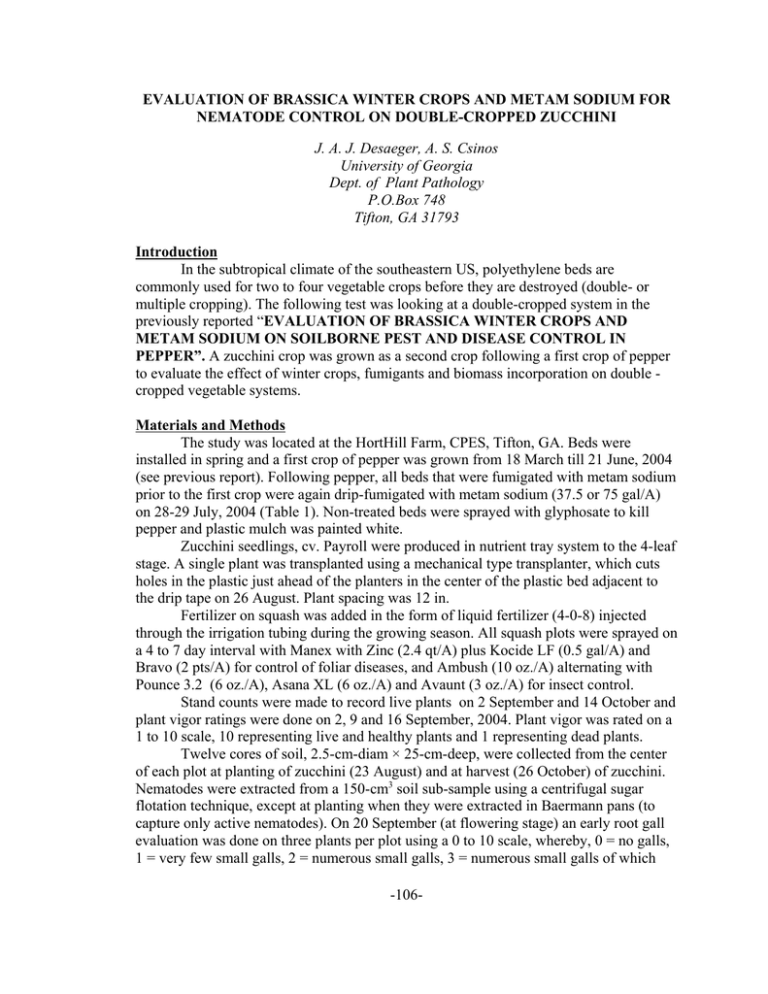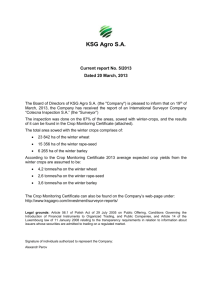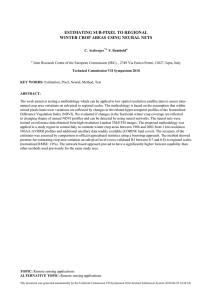EVALUATION OF BRASSICA WINTER CROPS AND METAM SODIUM FOR
advertisement

EVALUATION OF BRASSICA WINTER CROPS AND METAM SODIUM FOR NEMATODE CONTROL ON DOUBLE-CROPPED ZUCCHINI J. A. J. Desaeger, A. S. Csinos University of Georgia Dept. of Plant Pathology P.O.Box 748 Tifton, GA 31793 Introduction In the subtropical climate of the southeastern US, polyethylene beds are commonly used for two to four vegetable crops before they are destroyed (double- or multiple cropping). The following test was looking at a double-cropped system in the previously reported “EVALUATION OF BRASSICA WINTER CROPS AND METAM SODIUM ON SOILBORNE PEST AND DISEASE CONTROL IN PEPPER”. A zucchini crop was grown as a second crop following a first crop of pepper to evaluate the effect of winter crops, fumigants and biomass incorporation on double cropped vegetable systems. Materials and Methods The study was located at the HortHill Farm, CPES, Tifton, GA. Beds were installed in spring and a first crop of pepper was grown from 18 March till 21 June, 2004 (see previous report). Following pepper, all beds that were fumigated with metam sodium prior to the first crop were again drip-fumigated with metam sodium (37.5 or 75 gal/A) on 28-29 July, 2004 (Table 1). Non-treated beds were sprayed with glyphosate to kill pepper and plastic mulch was painted white. Zucchini seedlings, cv. Payroll were produced in nutrient tray system to the 4-leaf stage. A single plant was transplanted using a mechanical type transplanter, which cuts holes in the plastic just ahead of the planters in the center of the plastic bed adjacent to the drip tape on 26 August. Plant spacing was 12 in. Fertilizer on squash was added in the form of liquid fertilizer (4-0-8) injected through the irrigation tubing during the growing season. All squash plots were sprayed on a 4 to 7 day interval with Manex with Zinc (2.4 qt/A) plus Kocide LF (0.5 gal/A) and Bravo (2 pts/A) for control of foliar diseases, and Ambush (10 oz./A) alternating with Pounce 3.2 (6 oz./A), Asana XL (6 oz./A) and Avaunt (3 oz./A) for insect control. Stand counts were made to record live plants on 2 September and 14 October and plant vigor ratings were done on 2, 9 and 16 September, 2004. Plant vigor was rated on a 1 to 10 scale, 10 representing live and healthy plants and 1 representing dead plants. Twelve cores of soil, 2.5-cm-diam × 25-cm-deep, were collected from the center of each plot at planting of zucchini (23 August) and at harvest (26 October) of zucchini. Nematodes were extracted from a 150-cm3 soil sub-sample using a centrifugal sugar flotation technique, except at planting when they were extracted in Baermann pans (to capture only active nematodes). On 20 September (at flowering stage) an early root gall evaluation was done on three plants per plot using a 0 to 10 scale, whereby, 0 = no galls, 1 = very few small galls, 2 = numerous small galls, 3 = numerous small galls of which -106- some are grown together, 4 = numerous small and some big galls, 5 = 25 % of roots severely galled, 6 = 50 % of roots severely galled, 7 =75 % of roots severely galled, 8 = no healthy roots but plant is still green, 9 = roots rotting and plant dying, 10 = plant and roots dead. Again following final harvest on 19 October ten plants per plot were evaluated for root galls using that same scale. All zucchini fruits were hand-harvested from the 15-ft center area of each bed (15 plants per plot). Each harvest was separated into marketable and cull fruits, counted, and weighed. There were a total of three harvests, on 30 September and 6 and 13 October. All data collected was analyzed with an analysis of variance (P = 0.05) and means were separated using Duncan's Multiple range test. Summary Following fumigation with metam sodium, at planting of zucchini, populations of root-knot nematodes were significantly reduced, irrespective of fumigation application rate (Table 1). Root-knot nematode populations were numerically (but not significantly) less in plots that had rapeseed as a winter crop. Other plant-parasitic nematodes were low and not different among treatments. Free-living nematodes were also significantly reduced by fumigants. By harvest of zucchini, populations of root-knot nematodes had increased only moderately, and although no significant differences with regard to winter crop were noted, populations were still numerically higher with rye > turnip > rapeseed (Table 2). Fumigation did no longer have an effect on nematode populations at this stage, neither did biomass incorporation or removal. Zucchini growth, in terms of plant vigor and plant weight at mid season, was similar for all winter crops (Table 3). Fumigated plots, irrespective of fumigation application rate showed better growth than untreated plots. Biomass incorporation improved early plant vigor, but had no effect on late plant vigor. Root-knot gall indices at mid season and at harvest were significantly reduced following the low application rate of metam sodium, and to a smaller extent at the high application rate (Table 3). Previous winter crops and biomass incorporation/removal had no effect on gall indices. Zucchini yield, specifically the number of marketable fruits, were greater following turnip as compared to rye (Tables 4, 5). Significantly greater zucchini yields (~ 20%) were recorded following fumigation with metam sodium, regardless of application rate, as compared to untreated plots. Acknowledgments The authors wish to thank Jimmy Laska, Brian Horton, Tonya Jo Cravens, Unessee Hargett, Don Hickey, Lewis Mullis, and Chris Williamson for technical support. -107- Table 1. Populations of plant-parasitic and free-living nematodes at planting of zucchini, following a first crop of pepper, as affected by previous winter cover crops, pre-plant fumigant rates, and incorporation/removal of winter crop biomass, summer 2004, HortHill Farm Tifton, GA. Plant-parasitic nematode soil populations Factor Effects Free-living nematode soil populations Root-knot Sting Stubby Ring Bacteriovores Fungiovores Omniovores Total 107 67 150 NS 12 10 8 NS 2 1 2 NS 0.4 0 0 NS 995 1022 971 NS 85 78 91 NS 12 9 9 NS 1092 1110 1070 NS WINTER CROP Turnip Rapeseed Rye Fpr FUMIGANT RATE 75 gal/acre 37.5 gal/acre 0 gal/acre Fpr BIOMASS Incorporated Removed Fpr 34 b 24 b 266 a <0.01 9 10 12 NS 2 1 3 NS 0 0.4 0 NS 578 b 766 b 1644 a <0.01 34 b 46 b 174 a <0.01 4b 6b 19 a <0.01 616 b 818 b 1838 a <0.01 143 72 NS 9 12 NS 2.8 a 0.4 b 0.04 0.3 0 NS 1059 933 NS 88.2 81.1 NS 9 10 NS 1156 1024 NS INTERACTIONS Fpr (all) NS NS NS NS NS NS NS NS Nematode samples were collected on April 30; Root-knot nematode (Meloidogyne spp.); Sting nematode (Belonolaimus longicaudatus); Stubby root nematode (Trichodoridae); Ring nematodes (Criconemoides); B’vores = bacterial-feeding, F’vores = fungal-feeding, O’vores = predatory and omnivorous nematodes; Freeliving nematodes = non-parasitic nematodes. Data are means of five replications. Means in the same column followed by the same letter are not different (P = 0.05) according to Duncan’s multiple range test. No letters indicate non-significant difference; NS = not significant. -108- Table 2. Populations of plant-parasitic and free-living nematodes at harvest of zucchini, following a first crop of pepper, as affected by previous winter cover crops, pre-plant fumigant rates, and incorporation/removal of winter crop biomass, summer 2004, HortHill Farm Tifton, GA. Plant-parasitic nematode soil populations Factor effects Free-living nematode soil populations Root-knot Sting Stubby Ring Bacteriovores Fungiovores Omniovores Total Turnip Rapeseed Rye Fpr 174 124 319 NS 18 17 15 NS 3 4 2 NS 11 10 7 NS 1154 898 1015 NS 60 29 34 NS 6 6 5 NS 1263 953 1079 NS FUMIGANT RATE 75 gal/acre 37.5 gal/acre 0 gal/acre Fpr 255 (3.5) 143 (3.6) 218 (4.2) NS 14 19 17 NS 3 2 3 NS 2b 2b 24 a <0.01 998 1145 923 NS 28 42 52 NS 4 7 7 NS 1053 1208 1034 NS Incorporated Removed Fpr 254 157 0.08 18 15 NS 3 3 NS 12 7 NS 987 1057 NS 36 46 NS 5 7 NS 1060 1136 NS INTERACTION Fpr Winter crop*Fumigant Winter crop*Biomass Fumigant*Biomass Winter crop*Fumigant*Biomass INTERACTIONS Fpr (all) NS NS NS NS NS NS 0.03 0.09 0.03 NS NS NS NS NS NS NS NS NS NS NS NS NS NS NS NS NS NS NS NS NS NS NS NS NS NS NS NS NS NS NS WINTER CROP BIOMASS Nematode samples were collected on April 30; Root-knot nematode (Meloidogyne spp.); Sting nematode (Belonolaimus longicaudatus); Stubby root nematode (Trichodoridae); Ring nematodes (Criconemoides); B’vores = bacterial-feeding, F’vores = fungal-feeding, O’vores = predatory and omnivorous nematodes; Free-living nematodes = non-parasitic nematodes. Data are means of five replications. Means in the same column followed by the same letter are not different (P = 0.05) according to Duncan’s multiple range test. No letters indicate non-significant difference; NS = not significant. -109- Table 3. Plant vigor and root-gall indices of zucchini, following a first crop of pepper, as affected by previous winter cover crops, pre- plant fumigant rates, and incorporation/removal of winter crop biomass, summer 2004, HortHill Farm Tifton, GA. Plant vigor a Plant stand Fumigant Root gall index b At 2w At 1 w At 2 w At 3 w At 20 d At harvest Turnip Rapeseed Rye 15 a 15 a 14.5 b 7.5 7.6 7.7 7.9 7.9 8.0 8.6 8.4 8.6 1.4 1.3 1.6 4.6 4.6 4.5 Fpr 0.01 NS NS NS NS NS FUMIGANT RATE 75 gal/acre 37.5 gal/acre 0 gal/acre 15 15 15 7.9 a 7.8 a 7.0 b 8.3 a 8.1 a 7.4 b 8.9 a 8.9 a 7.8 b 1.4 ab 0.9 b 2.1 a 4.7 a 2.9 b 6.1 a Fpr NS <0.01 <0.01 <0.01 0.01 <0.01 Incorporated Removed 15 15 7.8 a 7.4 b 8.1 7.8 8.5 8.5 1.4 1.5 4.8 4.3 Fpr NS 0.05 NS NS NS NS INTERACTIONS Fpr (all) NS NS NS NS NS NS WINTER CROP BIOMASS a Vigor was done a 1-10 scale with 10= live and healthy plants and 1=dead plants;b Root Gall Index 0-10 scale whereby, 0 = no galls, 1 = very few small galls, 2 = numerous small galls, 3 = numerous small galls of which some are grown together, 4 = numerous small and some big galls, 5 = 25 % of roots severely galled, 6 = 50 % of roots severely galled, 7 =75 % of roots severely galled, 8 = no healthy roots but plant is still green, 9 = roots rotting and plant dying, 10 = plant and roots dead. Data are means of five replications. Means in the same column followed by the same letter are not different (P = 0.05) according to Duncan’s multiple range test. No letters indicate non-significant difference; NS = not significant. -110- Table 4. Fruit yield number of zucchini, following a first crop of pepper, as affected by previous winter cover crops, pre-plant fumigant rates, and incorporation/removal of winter crop biomass, summer 2004, HortHill Farm Tifton, GA. Number of marketable fruits* Fumigant Number of cull fruits Yield 1 Yield 2 Yield 3 Total Total 12.3 11.0 10.9 NS 5.7 5.3 5.3 NS 14.7 a 12.9 ab 12.0 b 0.08 32.6 a 29.1 ab 28.2 b 0.05 7.2 7.7 8.9 NS 12.8 a 13.5 a 7.8 b <0.01 5.7 5.2 5.4 NS 12.9 14.1 12.5 NS 31.5 a 32.8 a 25.6 b <0.01 8.7 8.1 6.7 NS 11.2 11.5 NS NS 5.3 5.5 NS NS 12.7 13.7 NS NS 29.2 30.7 NS NS 8.1 7.7 NS NS WINTER CROP Turnip Rapeseed Rye Fpr FUMIGANT RATE 75 gal/acre 37.5 gal/acre 0 gal/acre Fpr BIOMASS Incorporated Removed Fpr INTERACTIONS Fpr (all) * per 15 ft bed length; Data are means of five replications. Means in the same column followed by the same letter are not different (P = 0.05) according to Duncan’s multiple range test. No letters indicate non-significant difference; NS = not significant. -111- Table 5. Fruit yield weight of zucchini, following a first crop of pepper, as affected by previous winter cover crops, pre-plant fumigant rates, and incorporation/removal of winter crop biomass, summer 2004, HortHill Farm Tifton, GA. Weight of marketable fruits* Fumigant Weight of cull fruits Yield 1 Yield 2 Yield 3 Total Total Turnip Rapeseed Rye Fpr 10.0 9.7 8.9 NS 2.4 2.7 2.7 NS 16.3 a 14.0 ab 13.2 b 0.04 28.7 26.4 24.9 NS 5.5 6.5 7.1 NS FUMIGANT RATE 75 gal/acre 37.5 gal/acre 0 gal/acre 10.7 a 12.7 a 5.2 b 2.7 2.9 2.2 13.8 a 16.2 ab 13.4 b 27.3 a 31.8 a 20.8 b 7.4 a 6.5 ab 5.3 b Fpr <0.01 NS 0.05 <0.01 0.03 Incorporated Removed Fpr 7.8 9.3 NS 2.7 2.5 NS 13.5 15.5 0.05 26.0 26.3 NS 6.2 6.6 NS INTERACTIONS Fpr (all) NS NS NS NS NS WINTER CROP BIOMASS * per 15 ft bed length Data are means of five replications. Means in the same column followed by the same letter are not different (P = 0.05) according to Duncan’s multiple range test. No letters indicate non-significant difference; NS = not significant -112-




